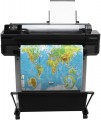Paper size
The paper size the plotter is designed to operate with. Most models use ISO 216 formats, identified by the letter A followed by a digit. These formats include the popular A4, but plotters usually work with larger paper:
- A0+. This marking means that the plotter is able to work with sheets larger than A0 (see below). The A0+ format itself provides a sheet width of 914 mm, however, in this case, support for wider media is usually provided — about 1100 mm (1050 – 1150 mm) in the most modest models of this format ( A0+ 44 ") and 1500 mm or more in the largest ( A0+ ≥ 60")
- A0. Paper of this format has a size of 1189x841 mm.
- A1. Paper size 841x594 mm — in other words, half of the A0 format.
- A2. A sheet of this format is approximately the size of a newspaper spread — 420x594 mm, half the size of A1. Considered relatively small by plotter standards.
- A3. The smallest format found in modern plotters: 297x420 mm, that is, only twice the standard A4 (in other words, with a magazine spread). Used in few desktop models (see Installation) — particularly, textile devices (see Product Type) for printing on T-shirts and other similarly sized clothes.
It is also worth noting that many models are able to work with other sizes. Moreover, we are talking not only about reduced, but also about la
...rger options: the maximum media width (see below) often exceeds the standard paper size.Print speed
The print speed provided by the plotter.
Such devices are intended for large-format material, so this parameter is usually indicated as m² per hour. Keep in mind that the spec usually give the maximum print speed, which is achieved at a reduced resolution and overall quality; in standard mode, the plotter may work noticeably slower. So when choosing for this parameter, it is worth taking a certain margin. On the other hand, according to the values indicated in the specs, it is quite possible to evaluate different models and compare them with each other: the difference in the claimed performance, usually, will proportionally correspond to the difference in the actual speed of work.
As for specific values, speed
up to 20 m²/h for modern plotters is considered low,
21 – 50 m²/h — medium, and in the most powerful and performant equipment this value can
exceed 50 m²/h.
Media width (max)
The largest width of paper or other media that the plotter can handle. The larger this parameter, the larger the materials that can be printed on the device; however, the dimensions, weight and cost of the plotter also increase markedly due to this.
Dimensions with stand (WxDxH)
The overall dimensions of the floor plotter (see “Placement”), including the stand, in other words, the dimensions of the device in the operative condition (in addition to the stand itself, other equipment, such as trays for printed materials, is taken into account here). This indicator is worth evaluating how much space is needed to install such a plotter.
Weight
The total weight of the plotter is usually listed without ink and paper. You should pay attention to this parameter foremost when choosing desktop models (see "Placement"): modern plotters are quite massive, which puts forward corresponding requirements for stands for them.

